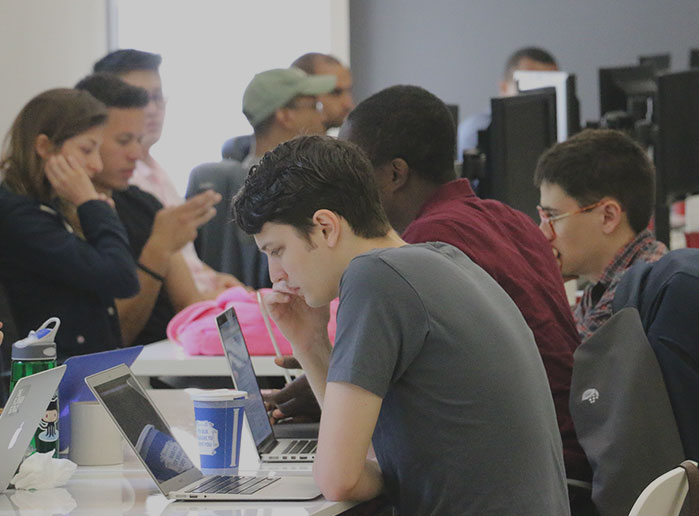In our Beyond the Bootcamp series, we chat with members of our alumni community about their post-Flatiron career journeys. What new roles have they taken on? What advice do they have for others hoping to follow in their footsteps?
Steven Brooks followed a unique path to his tech career: before Flatiron School, he played baseball professionally. Now, he’s the Engineering Manager for StreetEasy, one of Zillow’s New York City real estate brands. Read on to see what attracted Steven to programming, the similarities between baseball and coding, and his advice for aspiring programmers.
Learning to code
So why switch from playing pro baseball to coding? Steven spent his off seasons helping out at the startup where his brother worked. One of his responsibilities was managing the engineers, and he found himself “in awe of what they were able to do in a short amount of time.” As he describes it, “I could be there at midnight thinking of something I wanted to add to my brother’s company, and I couldn’t do it. But an engineer – they could do it. It’s a type of job where you can go from idea to actual tangible product – something that someone can touch and use – in the shortest amount of time.” Inspired, Steven started teaching himself how to code before coming to Flatiron School.
So do coding and baseball have anything in common? In programming, “you have to be comfortable with a little bit of discomfort,” according to Steven. “You’re not really going to get either right off the bat, and you have to go through a little bit of pain in order to understand everything. It’s the same thing with baseball. If you’re successful 3 times out of 10, you’re a multimillionaire, and you’re in the Hall of Fame.”
Takeaway #1:
According to Steven, the best way to learn to code is to “just get in there and figure out how to really build something. So build Twitter, build Facebook, whatever it is, but you’ll learn more valuable knowledge on how to program if you’re actually trying to build something and there’s some sort of end goal of something that you’d like to build. So just get in there. Don’t think. Just get in there.”
The Flatiron Experience
After hearing from a friend in Flatiron’s first-ever class who “only had the greatest things to say about it,” Steven joined Flatiron School’s second class. Steven had been learning on his own but felt he needed structure to take it to the next level. “Flatiron School obviously provided that and a lot more,” he says.
His favorite part of the experience? “I loved Feelings Fridays,” he says of Flatiron’s weekly group check-ins. “I would pour it all out there.” Steven notes that with no engineering background, it was a struggle to essentially retrain his mind to think like a programmer. But in these weekly meetings, “I could look to my left or I could look to my right, and for the most part, everyone was exactly where I was in the struggle – all working towards the same goal. I didn’t feel alone.”
Takeaway #2:
For Steven, the most important skill he learned at Flatiron was how to break down problems into their smallest parts. “Now that I’m more involved in the business end at StreetEasy, it’s very helpful for me to be able to think that way. If we have a big goal, like make X amount of money next year on rentals, that’s a huge goal – but if you break it down to its smallest parts like you’d do making an app, it helps tremendously. When I work with the product team on what tasks eventually get to the engineering team, that also works really well. For the engineers, the smaller the task, the quicker they’re able to get through it, and our velocity picks up a lot.”
Though Steven was nervous before starting at StreetEasy (“you’re afraid someone’s going to find out that you’re not as good as you think you are”), he quickly realized that being an active member of the team at StreetEasy involves a lot more than just having good technical chops: “Can you learn quickly? Can you be a good member of the team, and can you provide some sort of value?” Steve says. “No one’s really expecting you, as a junior engineer, to be able to create everything and do all the bells and whistles that a senior engineer does, but they do expect you to be part of a team.” Steven thrived in the team environment at StreetEasy and worked his way up to becoming their Engineering Manager.

A shot of the StreetEasy office.
As Engineering Manager, Steven spends each morning running standups with StreetEasy’s engineering teams (including 30 offshore engineers) as well as the company’s customer support, product, and business teams. He will always take lunch, and recommends aspiring developers make sure to step away from their desks: “I never skip it. It’s blocked off my calendar. I won’t be successful in the afternoon if I can’t kind of clear my head. The people that eat at their desks or don’t have lunch at all – I don’t think they’re as effective in the afternoon.” For the rest of the afternoon, Steven works with engineers and the product team to align their communications and build out products – making sure the engineering team gets the requirements for products far in advance “so that the engineers have all the tools they need to succeed by the time they actually get the task.”
Takeaway #3:
Steven credits his success at StreetEasy to his willingness to communicate – and especially ask questions. “There’s this concept of an engineer who’s stuck in this rabbit hole,” says Steven. “Maybe it’s because I was able to swallow my pride a little bit easier than some other people, but I never really did that. I had my own rule, where if I couldn’t understand a problem after 15 minutes, I would ask someone. Because if it was going to take me three hours to figure it out on my own and someone could help me in ten minutes – well that’s going to save the team a lot of time. So don’t get stuck in that rabbit hole. There’s never a question too embarrassing or an answer too obvious, especially with the type of community we have around programming.”
What’s next for Steven?
When asked about his career goals, Steven has a simple answer: “I want to be the GM of Zillow’s New York office in the next 4 years.” Given his determination, that outcome wouldn’t surprise us at all.
Ready to take Steven’s advice and start building something? The best way to get started is our free Bootcamp Prep course. Stay tuned for more installments of “Beyond the Bootcamp”!
Written byJOSH HIRSHFELD
Content Marketing Manager, Flatiron School

